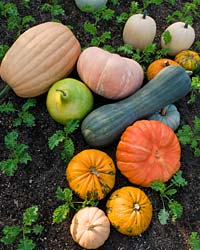 With their bright colors and unusual shapes, gourds are not only beautiful, but are also a wonderful medium for craftspeople. Carve, wax, stain, or varnish them; paint or dye them; use wood-burning tools on them to create highly decorative objects of art. And they’re utilitarian as well. Many cultures have used gourds as containers (serving and storage vessels, dippers, planters, salt shakers), jewelry, toys, musical instruments (flutes, marimbas, zither lutes, sitars, guitars, drums, and rattles) and birdhouses (North American Indians used them to attract purple martins).
With their bright colors and unusual shapes, gourds are not only beautiful, but are also a wonderful medium for craftspeople. Carve, wax, stain, or varnish them; paint or dye them; use wood-burning tools on them to create highly decorative objects of art. And they’re utilitarian as well. Many cultures have used gourds as containers (serving and storage vessels, dippers, planters, salt shakers), jewelry, toys, musical instruments (flutes, marimbas, zither lutes, sitars, guitars, drums, and rattles) and birdhouses (North American Indians used them to attract purple martins).
You can even make puppets from gourds, turn them into handsome Christmas tree ornaments, or carve them into great-looking jack-o'-lanterns. You can do almost anything to gourds you can do to wood, and not suffer the splinters.
While their origin remains a mystery, there is evidence of gourds in the early civilizations of Africa, Asia, North and South America, Australia, and New Zealand. One theory attributes their widespread distribution to oceanic currents that carried the lightweight, waterproof, buoyant gourds great distances.
TYPES OF GOURDS
Gourds belong to the large cucurbit family, which also includes pumpkins, squash, melons, and cucumbers. Gourds are differentiated from their cousins by their hard, durable shells, and general inedibility. There are three categories: lagenaria, the large, hard-shelled gourds that sometimes grow more than 20 inches in diameter; the smaller ornamental gourds with thick, soft shells; and the less commonly grown luffa gourds that are valued in Europe for their spongy interiors.
Lagenaria gourds come in several different shapes that define their uses: basket, bottle, dipper, and snake. The ornamentals are strictly for show. Brilliantly colored, often striped, mottled, warted, or grooved, they’re fascinating in their infinite variety — nest egg, orange, apple, pear, spoon, bell, crown of thorns, Turk’s cap and more. These gourds are popular in home gardens since all of them are smaller than 6 inches.
GROWING GOURDS
Gourds require at least 120 frost-free days to mature. Therefore, they should be started indoors in March and moved outside to the garden when all danger of frost has passed. Some gardeners cover the ground with black plastic to absorb sunlight and warm the soil since gourd plant roots need as much heat as they can get.
Gourds require full sun, regular fertilizer, water, space, and support. Plant them either in hills or rows with 8 feet between the hills, or 4 feet between the row plants. Each plant can grow 15 to 20 feet and produce 12 or more fruits. A slightly acid soil is ideal, with a pH between 6.0 and 6.5. Harvest gourds after the first killing frost and leave 1 to 2 inches of stem attached. This is important. A gourd is 90 percent water, and this water must evaporate through the stem so that the gourd can dry properly.
CURING AND STORING
Store gourds in a cool place, out of direct sunlight, which will fade the colors. Plan to wait at least nine months for the gourd to dry; some take as much as one and a half years. The worst pest of gourds is the cucumber beetle, which damages vines and spreads disease. It’s a good idea to remove all vines from the garden after harvest to avoid overwintering insects.
Many craft and antique stores feature gourd art in their seasonal displays, and local society members and hobbyists sponsor shows and sales during the autumn months. Who would expect that such an unlikely vegetable could one day become fine art!

